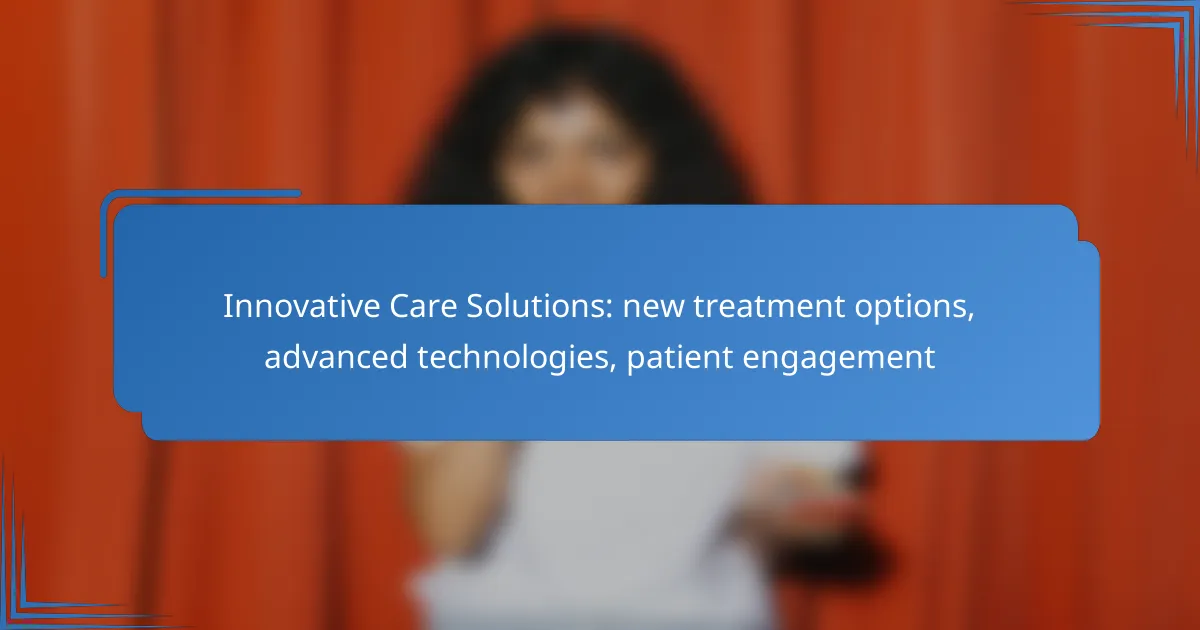Innovative care solutions are transforming the healthcare landscape by integrating advanced technologies and new treatment options that prioritize patient outcomes. From telehealth services to wearable health technology, these innovations not only enhance diagnostic accuracy and treatment efficacy but also actively engage patients in their own health management. By fostering effective communication and empowering patients, these solutions pave the way for a more personalized and efficient healthcare experience.
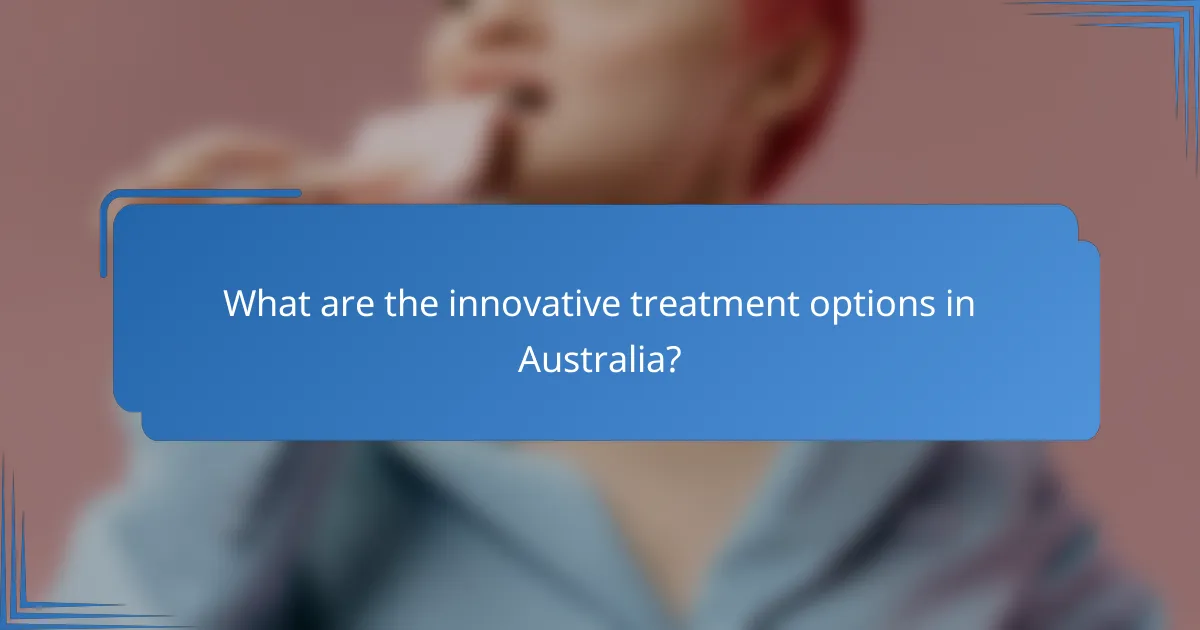
What are the innovative treatment options in Australia?
Innovative treatment options in Australia encompass a range of advanced technologies and methodologies aimed at improving patient outcomes. These solutions include telehealth services, personalized medicine, gene therapy advancements, wearable health technology, and digital therapeutics, all designed to enhance care delivery and patient engagement.
Telehealth services
Telehealth services allow patients to consult healthcare providers remotely using digital communication tools. This approach is particularly beneficial for individuals in rural areas or those with mobility challenges, as it reduces travel time and increases access to specialists.
In Australia, telehealth has gained traction, especially during the COVID-19 pandemic, leading to regulatory changes that support its use. Patients can engage in video consultations, receive prescriptions, and even access mental health services online.
Personalized medicine
Personalized medicine tailors treatment plans based on an individual’s genetic makeup, lifestyle, and environment. This approach enhances the effectiveness of therapies by ensuring they are suited to the specific characteristics of the patient.
In Australia, advancements in genomic testing have made personalized medicine more accessible, allowing healthcare providers to offer targeted therapies for conditions like cancer and chronic diseases. Patients should discuss genetic testing options with their healthcare professionals to understand potential benefits.
Gene therapy advancements
Gene therapy advancements involve modifying or replacing genes to treat or prevent diseases. This innovative approach holds promise for genetic disorders and certain types of cancer, potentially offering long-term solutions rather than symptomatic relief.
In Australia, ongoing research and clinical trials are exploring gene therapies for conditions such as cystic fibrosis and hemophilia. Patients interested in these options should consult with specialists to evaluate eligibility and understand the risks and benefits involved.
Wearable health technology
Wearable health technology includes devices like fitness trackers and smartwatches that monitor various health metrics, such as heart rate, activity levels, and sleep patterns. These tools empower patients to take charge of their health by providing real-time data.
In Australia, the integration of wearables into healthcare is growing, with some devices offering features that allow for remote monitoring by healthcare providers. Patients should choose wearables that align with their health goals and ensure they understand how to interpret the data collected.
Digital therapeutics
Digital therapeutics are software-based interventions designed to prevent, manage, or treat medical conditions. These programs often complement traditional therapies and can be used for mental health, chronic disease management, and rehabilitation.
In Australia, digital therapeutics are becoming increasingly recognized, with some programs receiving regulatory approval. Patients should explore available options and consider integrating these digital solutions into their overall treatment plans for enhanced support and engagement.

How do advanced technologies enhance patient care?
Advanced technologies significantly enhance patient care by improving diagnostic accuracy, streamlining surgical procedures, and enabling continuous health monitoring. These innovations lead to better outcomes, increased efficiency, and greater patient engagement in their own health management.
Artificial intelligence in diagnostics
Artificial intelligence (AI) in diagnostics utilizes machine learning algorithms to analyze medical data, improving the speed and accuracy of disease detection. For instance, AI can evaluate medical images, such as X-rays or MRIs, identifying anomalies that may be missed by the human eye.
Healthcare providers should consider integrating AI tools that comply with regulatory standards, such as those set by the FDA in the United States or the EMA in Europe. These tools can assist in triaging patients more effectively and personalizing treatment plans.
Robotic surgery systems
Robotic surgery systems enhance precision in surgical procedures, allowing surgeons to perform complex operations with minimal invasiveness. These systems provide enhanced visualization and dexterity, which can lead to shorter recovery times and reduced post-operative complications.
When considering robotic surgery, patients should discuss the potential benefits and risks with their healthcare providers. It’s essential to ensure that the surgical team is well-trained in using these advanced systems to maximize safety and effectiveness.
Remote monitoring devices
Remote monitoring devices allow healthcare providers to track patients’ vital signs and health metrics in real-time, even outside of clinical settings. This technology is particularly beneficial for managing chronic conditions, as it enables timely interventions when abnormalities are detected.
Patients should be aware of the types of remote monitoring devices available, such as wearable fitness trackers or implantable sensors, and how they can contribute to their health management. Engaging with these technologies can empower patients to take an active role in their care, leading to better health outcomes.
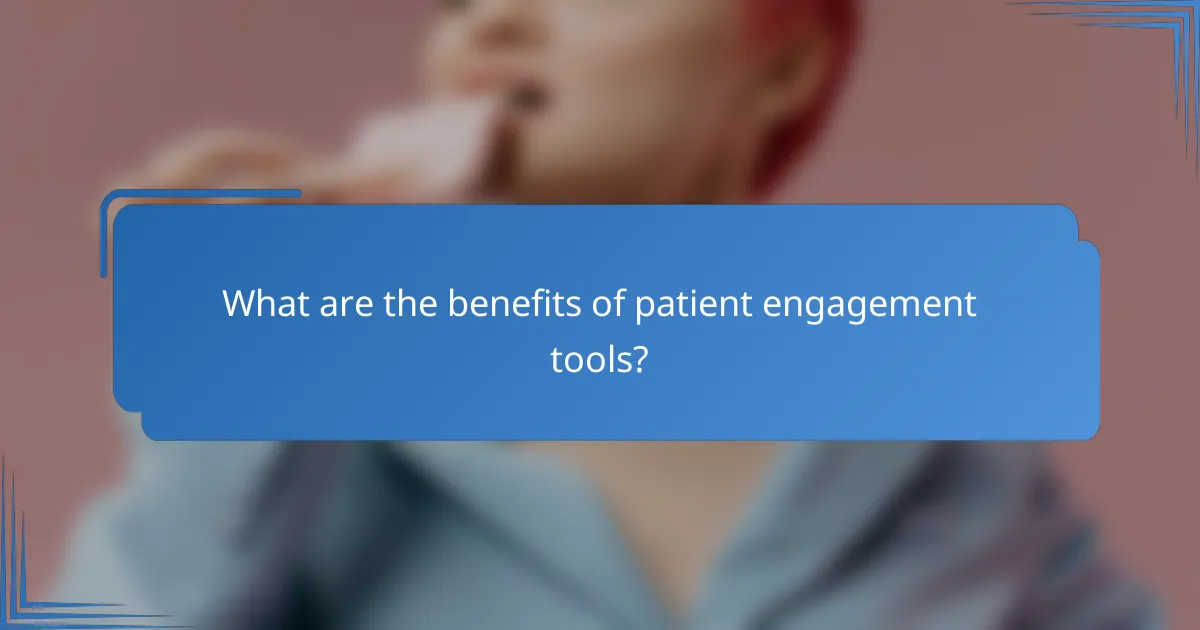
What are the benefits of patient engagement tools?
Patient engagement tools enhance the interaction between patients and healthcare providers, leading to better health outcomes. These tools empower patients to take an active role in their care, improving adherence to treatment plans and fostering effective communication.
Improved treatment adherence
Patient engagement tools significantly boost treatment adherence by providing reminders and educational resources. For instance, mobile apps can send notifications for medication schedules, helping patients remember to take their prescriptions on time.
Additionally, these tools often include tracking features that allow patients to monitor their progress. This visibility can motivate patients to stick to their treatment plans, ultimately leading to better health results.
Enhanced communication with providers
Effective communication between patients and providers is crucial for successful treatment. Patient engagement tools facilitate this by offering secure messaging systems, allowing patients to ask questions or report issues directly to their healthcare team.
Moreover, these tools can provide a platform for telehealth consultations, making it easier for patients to connect with providers without the need for in-person visits. This accessibility can lead to quicker resolutions of health concerns.
Access to health information
Patient engagement tools grant patients easy access to their health information, including lab results and treatment plans. This transparency helps patients understand their conditions better and make informed decisions about their care.
Many platforms also offer educational materials tailored to specific health issues, enabling patients to learn more about their conditions. This knowledge can empower patients to engage more actively in their treatment and lifestyle choices.
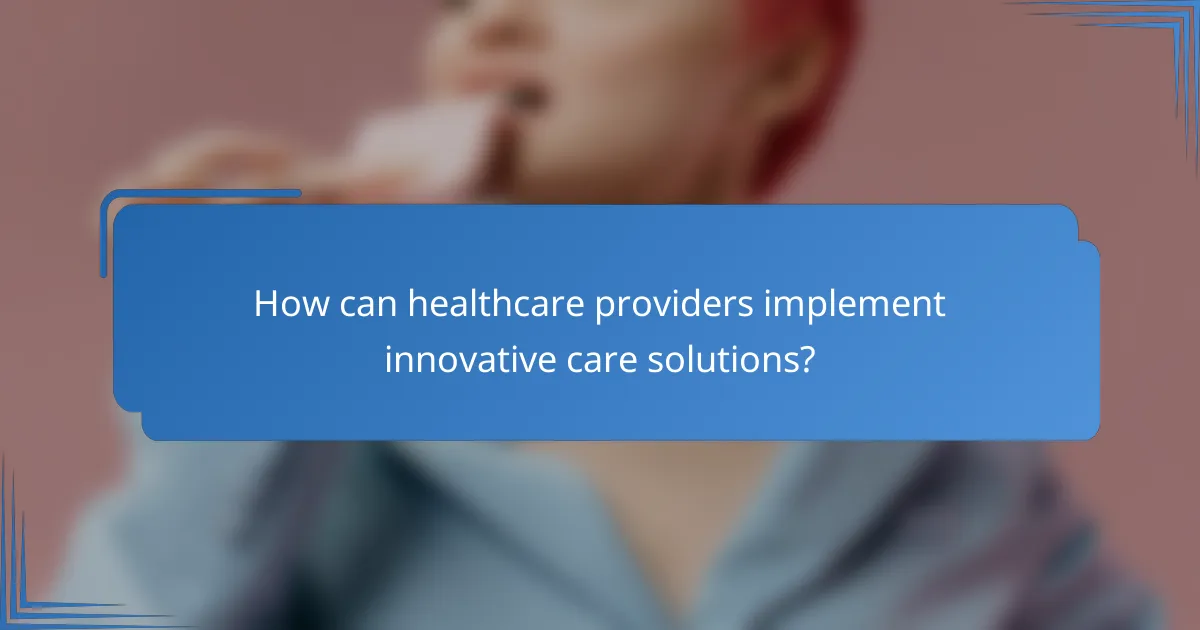
How can healthcare providers implement innovative care solutions?
Healthcare providers can implement innovative care solutions by adopting advanced technologies, training staff, and integrating these solutions into their existing workflows. This approach enhances patient engagement and improves overall care quality.
Training staff on new technologies
Effective training is crucial for staff to utilize new technologies successfully. Providers should offer comprehensive training programs that cover the features and benefits of the technology, ensuring staff are comfortable and proficient in its use.
Consider using a mix of training methods, such as hands-on workshops, online courses, and ongoing support. This variety caters to different learning styles and helps reinforce knowledge over time.
Integrating solutions into existing workflows
Integrating innovative care solutions requires a careful assessment of current workflows to identify areas for improvement. Streamlining processes can enhance efficiency and reduce disruptions during the transition.
Utilize pilot programs to test new solutions in a controlled environment before full implementation. This approach allows for adjustments based on real-world feedback and minimizes potential challenges.
Evaluating patient feedback
Gathering and analyzing patient feedback is essential for assessing the effectiveness of new care solutions. Providers should implement regular surveys and focus groups to capture patient experiences and satisfaction levels.
Use this feedback to make informed adjustments to services and technologies. Engaging patients in the evaluation process fosters a sense of ownership and can lead to improved outcomes and satisfaction.
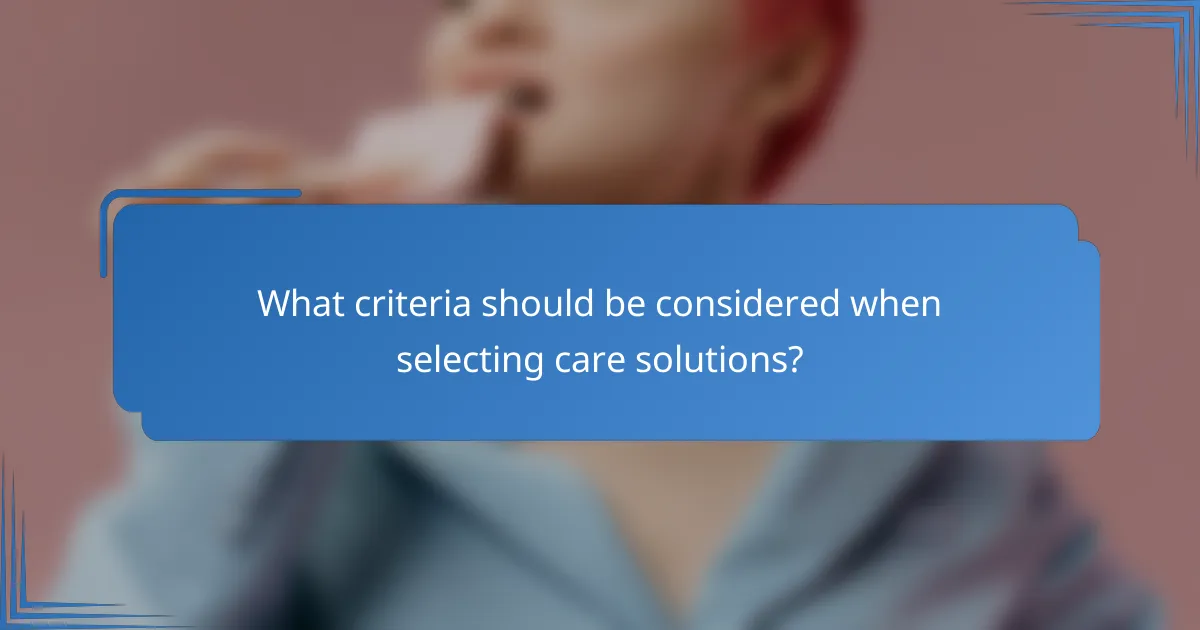
What criteria should be considered when selecting care solutions?
When selecting care solutions, it is essential to evaluate factors such as cost-effectiveness, compatibility with existing systems, and regulatory compliance. These criteria ensure that the chosen solutions not only fit within budget constraints but also integrate smoothly into current operations and adhere to necessary regulations.
Cost-effectiveness
Cost-effectiveness is a critical criterion when choosing care solutions, as it directly impacts the overall budget. Evaluate both initial investment and long-term operational costs, including maintenance and training. Aim for solutions that provide a clear return on investment, potentially saving tens of thousands of dollars over time.
Consider conducting a cost-benefit analysis to compare different options. This analysis should include direct costs, potential savings from improved efficiency, and any qualitative benefits such as enhanced patient satisfaction.
Compatibility with existing systems
Compatibility with existing systems is vital to ensure seamless integration and avoid disruptions. Assess how new solutions will interact with current software, hardware, and workflows. Solutions that require extensive modifications may lead to increased costs and longer implementation times.
Look for care solutions that offer interoperability with widely used platforms. This can simplify data sharing and improve overall efficiency, allowing for better patient care without overhauling existing infrastructure.
Regulatory compliance
Regulatory compliance is a non-negotiable aspect of selecting care solutions, particularly in healthcare environments. Ensure that any new technology meets local and national regulations, such as HIPAA in the United States or GDPR in Europe, which protect patient data and privacy.
Regularly review compliance requirements as they can change over time. Engage with legal and compliance experts to verify that selected solutions adhere to all necessary standards, thereby minimizing the risk of costly fines or legal issues.
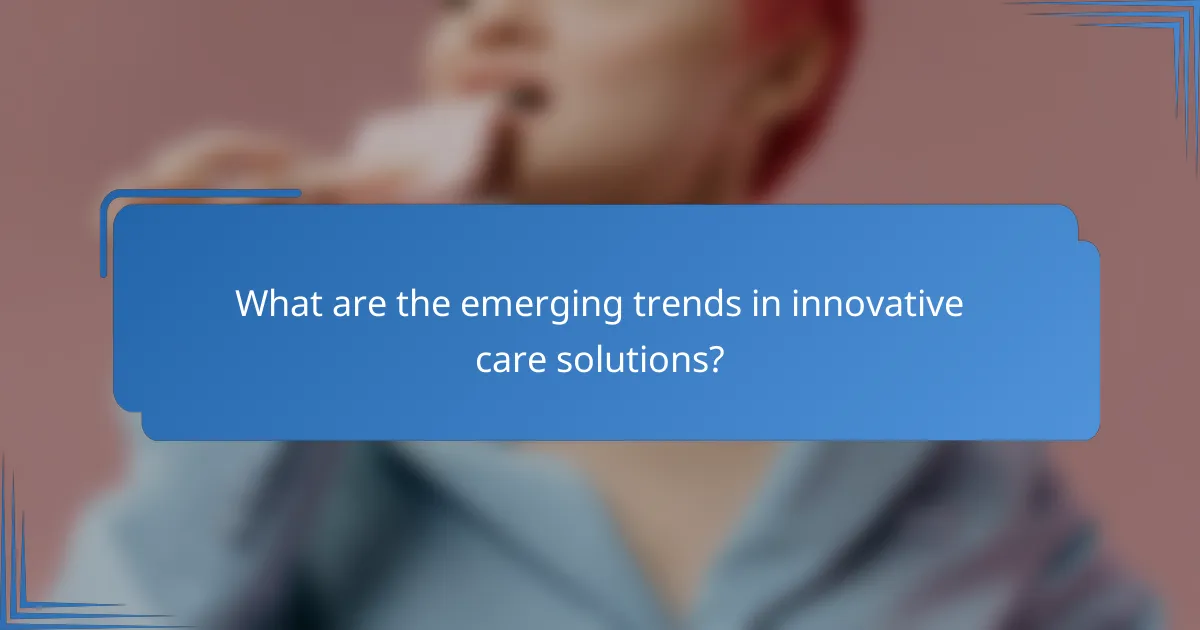
What are the emerging trends in innovative care solutions?
Emerging trends in innovative care solutions focus on new treatment options, advanced technologies, and enhanced patient engagement. These trends aim to improve healthcare delivery, increase efficiency, and empower patients in managing their health.
New treatment options
New treatment options are increasingly personalized, utilizing genetic information and patient data to tailor therapies. For instance, precision medicine allows for targeted treatments based on individual genetic profiles, which can lead to better outcomes and fewer side effects.
Additionally, telemedicine has gained traction, providing patients with access to healthcare professionals from the comfort of their homes. This approach is particularly beneficial for those in remote areas or with mobility challenges, as it reduces travel time and costs.
Advanced technologies
Advanced technologies such as artificial intelligence (AI) and machine learning are transforming healthcare by enabling predictive analytics and automating routine tasks. These technologies can analyze vast amounts of data to identify trends and potential health risks, allowing for proactive interventions.
Wearable devices are another significant advancement, allowing continuous monitoring of vital signs and health metrics. These devices can alert both patients and healthcare providers to any concerning changes, facilitating timely responses and interventions.
Patient engagement
Patient engagement is crucial for successful healthcare outcomes, and innovative solutions are enhancing this aspect. Mobile health applications empower patients to track their health, schedule appointments, and communicate with providers, fostering a more active role in their care.
Moreover, educational resources and support groups available online help patients understand their conditions better and connect with others facing similar challenges. This community support can improve adherence to treatment plans and overall satisfaction with care.
